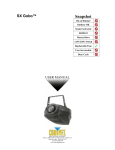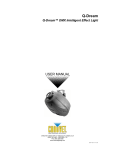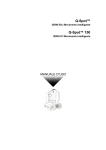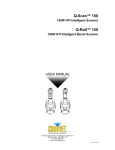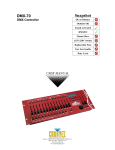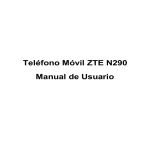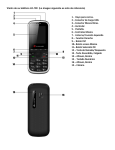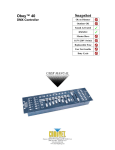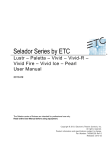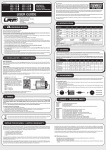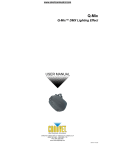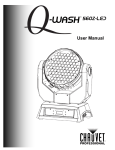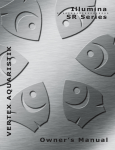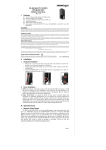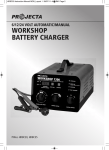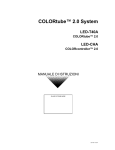Download Q-Spot™ Q-Spot™ 150
Transcript
Q-Spot™
250W EHJ Intelligent Moving Yoke
Q-Spot™ 150
150W HTI Intelligent Moving Yoke
USER MANUAL
CHAUVET, 3000 N 29th Ct, Hollywood, FL 33020 U.S.A
(800) 762-1084 – (954) 929-1115
FAX (954) 929-5560
www.chauvetlighting.com
2005-11-15/13:11
Table of Content
BEFORE YOU BEGIN....................................................................................................................................................... 3
WHAT IS INCLUDED .......................................................................................................................................................................................................... 3
UNPACKING INSTRUCTIONS .............................................................................................................................................................................................. 3
AC POWER ..................................................................................................................................................................................................................... 3
SAFETY INSTRUCTIONS .................................................................................................................................................................................................... 3
INTRODUCTION ............................................................................................................................................................... 4
TECHNICAL FEATURES ..................................................................................................................................................................................................... 4
FEATURES ....................................................................................................................................................................................................................... 4
FOREWORD ..................................................................................................................................................................................................................... 4
DMX CHANNEL SUMMARY ............................................................................................................................................................................................... 5
PRODUCT OVERVIEW....................................................................................................................................................................................................... 6
SETUP .............................................................................................................................................................................. 7
LAMP............................................................................................................................................................................................................................... 7
Lamp Installation ................................................................................................................................................................................................ 7
Lamp Alignment How-To.................................................................................................................................................................................... 7
POWER ........................................................................................................................................................................................................................... 8
EXCHANGING GOBOS ....................................................................................................................................................................................................... 8
MOUNTING ...................................................................................................................................................................................................................... 9
OPERATING INSTRUCTIONS ........................................................................................................................................ 10
CONTROL PANEL ........................................................................................................................................................................................................... 10
CONTROL PANEL FUNCTIONS......................................................................................................................................................................................... 10
APPLYING CHANGES TO FUNCTIONS (QUICK INSTRUCTIONS) .......................................................................................................................................... 10
OPERATING MODES ....................................................................................................................................................................................................... 11
Master/Stand Alone.......................................................................................................................................................................................... 11
Setting Slave Fixtures ...................................................................................................................................................................................... 11
DMX Mode........................................................................................................................................................................................................ 12
Daisy Chain Connection................................................................................................................................................................................... 12
MENU FUNCTIONS ......................................................................................................................................................................................................... 12
DMX-512 addressing ............................................................................................................................................................................................. 12
Setting the starting address ............................................................................................................................................................................. 12
User Configurations ............................................................................................................................................................................................... 13
(P1-y) – 16 bit Control ...................................................................................................................................................................................... 13
Default (P1-n) & P3 – 8 bit Control................................................................................................................................................................... 13
P-4 – {Function reserved and not in use}......................................................................................................................................................... 13
P5 - Pan Invert / P6- Tilt Invert......................................................................................................................................................................... 13
Segment Display Configurations ........................................................................................................................................................................... 14
PC - Display Invert ........................................................................................................................................................................................... 14
Service Functions .................................................................................................................................................................................................. 14
P7 - Fixture Reset (all motors) ......................................................................................................................................................................... 14
Pb - Fixture Partial Reset (excludes Pan & Tilt) .............................................................................................................................................. 14
H000 - Fixture Hours........................................................................................................................................................................................ 14
Resetting Fixture Hours.................................................................................................................................................................................... 14
APPENDIX ...................................................................................................................................................................... 15
DMX PRIMER ................................................................................................................................................................................................................ 15
Fixture Linking .................................................................................................................................................................................................. 15
DMX CHANNEL VALUES (16 BIT) ................................................................................................................................................................................... 16
MAINTENANCE ............................................................................................................................................................................................................... 17
RETURNS PROCEDURE .................................................................................................................................................................................................. 17
CLAIMS ......................................................................................................................................................................................................................... 17
GENERAL TROUBLESHOOTING ....................................................................................................................................................................................... 18
TECHNICAL SPECIFICATIONS .......................................................................................................................................................................................... 19
Q-Spot & Q-Spot 150 User Manual
2
2005-11-15/13:11
BEFORE YOU BEGIN
What is included
Q-Spot™ & EHJ lamp
or
Q-Spot™ 150 & HTI150 lamp
Power cord with plug
Manual
Warranty Card
Unpacking Instructions
Immediately upon receiving a fixture, carefully unpack the carton, check the contents to ensure that
all parts are present, and have been received in good condition. Notify the shipper immediately and
retain packing material for inspection if any parts appear damaged from shipping or the carton itself
shows signs of mishandling. Save the carton and all packing materials. In the event that a fixture
must be returned to the factory, it is important that the fixture be returned in the original factory box
and packing.
AC Power
To determine the power requirements for a particular fixture, see the label affixed to the back plate of
the fixture or refer to the fixture’s specifications chart. A fixture’s listed current rating is its average
current draw under normal conditions. All fixtures must be powered directly off a switched circuit and
cannot be run off a rheostat (variable resistor) or dimmer circuit, even if the rheostat or dimmer
channel is used solely for a 0% to 100% switch. Before applying power to a Figure 1 - AC Voltage Switch
fixture, check that the source voltage matches the fixture’s requirement.
Check the fixture or device carefully to make sure that if a voltage selection
switch exists that it is set to the correct line voltage you will use.
Warning!
Verify that the power select switch on your unit matches the
line voltage applied. All fixtures must be connected to circuits
with a suitable Earth Ground.
Safety Instructions
Please read these instructions carefully, which includes important
information about the installation, usage and maintenance?
Please keep this User Guide for future consultation. If you
sell the unit to another user, be sure that they also receive
this instruction booklet.
Always make sure that you are connecting to the proper
voltage and that the line voltage you are connecting to is
not higher than that stated on decal or rear panel of the
fixture.
This product is intended for indoor use only!
To prevent risk of fire or shock, do not expose fixture to
rain or moisture. Make sure there are no flammable
materials close to the unit while operating.
The unit must be installed in a location with adequate
ventilation, at least 50cm from adjacent surfaces. Be sure
that no ventilation slots are blocked.
Always disconnect from power source before servicing or
replacing lamp or fuse and be sure to replace with same
lamp source.
Caution!
Secure fixture to fastening device using a safety chain.
Never carry the fixture solely by its head. Use its carrying
handles.
Maximum ambient temperature is Ta: 40°. Do not operate
fixture at temperatures higher than this.
In the event of serious operating problem, stop using the
unit immediately. Never try to repair the unit by yourself.
Repairs carried out by unskilled people can lead to
damage or malfunction. Please contact the nearest
authorized technical assistance center. Always use the
same type spare parts.
Don’t connect the device to a dimmer pack.
Make sure power cord is never crimped or damaged.
Never disconnect power cord by pulling or tugging on the
cord.
Avoid direct eye exposure to lamp while it is on.
There are no user serviceable parts inside the unit. Do not open the housing or
attempt any repairs yourself. In the unlikely event your unit may require service,
please contact CHAUVET.
Q-Spot & Q-Spot 150 User Manual
3
2005-11-15/13:11
INTRODUCTION
Technical Features
6-9 channel DMX Intelligent Scanner
Pan: 540°
Tilt: 270°
Pan/Tilt speed & reset control channel
Mechanical Dimmer/Shutter/Strobe
Rotating Gobos
- 7 interchangeable rotating gobos
- 5 metal, 2 glass
- Gobo Bounce™
- Gobo wheel spin
- in both directions, at variable speeds
Color Wheel
- 9 colors plus open
- Rainbow color spin
- in both directions, at variable speeds
Gobo rotation control channel
Features
Automatic Pan/Tilt correction
Built in beat activated and automatic programs
(stand-alone)
User selectable 8 or 16 bit movement
resolution
Foreword
LED display menu with invert
Pan/Tilt Invert option
Micro-stepping motors
Thermal switch
Both the Q-Spot™ and the Q-Spot™ 150 fixtures are identical in electromechanical effects and
control. The main difference lies in the lamp each product uses.
The Q-Spot™ 150 utilizes the HTI® 150 High Intensity Discharge lamp source. This is a modern lamp
technology that provides higher color temperature of the light beam, at 6,500°Kelvin, longer lamp life
and lower power consumption at only 150 watts. This color is considered true white, also known as
daylight.
The Q-Spot™ uses the ever popular EHJ halogen lamp. It is a powerful and economical lamp. At 250
watts it provides just over of the same intensity measured in lumens as the HTI® 150 though at the
expense of shorter life. However, the EHJ is a much more economical purchase than the HTI® 150.
Both lamps are well suited for the job.
Brief Lamp specifications
LAMP
LUMENS
HTI® 150
9,500
EHJ
10,000
Q-Spot & Q-Spot 150 User Manual
LIFE
750 hrs
50 hrs
4
2005-11-15/13:11
DMX Channel Summary
There are 4 fixture DMX personality configurations in both fixtures. These settings are user selectable
using the control panel interface.
Default Setting =
CHANNEL
FUNCTION
CHANNEL
FUNCTION
1
Pan
4
Gobo
2
Tilt
5
Color
3
Shutter/Dimmer
6
Gobo Rotation
Setting =
CHANNEL
FUNCTION
CHANNEL
FUNCTION
1
Pan
6
Shutter/Dimmer
2
Tilt
7
Gobo
3
Pan (Fine)
8
Color
4
Tilt (Fine)
9
Gobo Rotation
5
Pan/Tilt Speed
Setting =
CHANNEL
FUNCTION
CHANNEL
FUNCTION
1
Pan
6
Shutter/Dimmer
2
Pan (Fine)
7
Gobo
3
Tilt
8
Color
4
Tilt (Fine)
9
Gobo Rotation
5
Pan/Tilt Speed
Setting =
CHANNEL
FUNCTION
CHANNEL
FUNCTION
1
Pan
5
Gobo
2
Tilt
6
Color
3
Pan/Tilt Speed
7
Gobo Rotation
4
Shutter/Dimmer
Q-Spot & Q-Spot 150 User Manual
5
2005-11-15/13:11
Introduction
Product Overview
2
2
1
1. Moving yoke arm
2. Projector head
3. Base
4. Carrying handle
5. Fan
6. LED signal indicator
7. LED display
8. [Enter] button
9. [Choose] button
10. [Up] button
11. [Down] button
12. DMX output
4
13. DMX input
14. Carrying handle
15. AC input IEC 60320 C14
16. Fuse holder
17. Power switch
5
3
7
6
Control Panel
12
Enter
Choose
Up
Down
8
9
10
11
13
14
15
16
17
SEGMENT BUTTONS I/O PANEL OVERVIEW
BUTTONS
I/O PANEL
Choose
Toggles programming
functions
DMX Out & In
DMX-512 connectors
Down
Steps backward through menu
functions
Power
AC input IEC 60320 C14 and fuse holder
Up
Steps forward through menu
functions
Enter
Confirms selected menu
function
Q-Spot & Q-Spot 150 User Manual
6
2005-11-15/13:11
SETUP
Lamp
You will need to install a lamp prior to the initial operation of the fixture. Depending on your particular
unit, either a HTI150 high intensity discharge lamp or an EHJ halogen lamp is included.
Warning!
When replacing the lamp, please wait 15 minutes after powering down to allow the
unit to cool down! Always disconnect from main power prior to lamp replacement.
Do not touch the envelope (glass area) of the bulb with bare hands. If this happens, clean the lamp
with alcohol and wipe it with a lint free cloth before installation.
L am p In st a ll at io n
1. Remove screws labeled (S1) and pull out lamp socket
plate.
S2
2. If replacing the lamp, remove old lamp first.
3. Holding the new lamp by its base, align the pins on the
lamp with the small hole in the socket and insert the
lamp squarely until the retaining clips on the lamp
socket secure the lamp tightly.
4. Clean the glass/envelope of the bulb with an alcohol
wipe or equivalent.
5. Holding the lamp socket plate, insert the tip of the lamp into the
fixture with extreme care. Navigate the lamp all the way until it
reaches the reflector and the lamp base plate touches the
bottom plate of the fixture.
S1
6. Align the screw holes and fasten the screws back onto the
lamp socket plate.
7. If you are replacing the lamp, you may want to log the fixture
hours in order to track the lamps use. Navigate to the H000
on the menu display to obtain this information.
8. Turn the fixture on and adjust the lamp alignment screws
(S2) until the brightest most even area of the beam is in the
center of your spot. It may be necessary for you to use a controller in order to command the fixture
to display a white beam on a flat surface with no colors.
Maximizing the life of your lamp
To ensure the longest and most efficient use of the lamp always wait
between 10 and 15 minutes before re-applying power after a shutdown.
Failure to do so could result in premature aging of the lamp and failure to
the electronics that drive it.
Q-Spot & Q-Spot 150 User Manual
7
2005-11-15/13:11
Introduction
Lamp Alignment How-To
Often, after a new installation of a lamp, you will find that
there is an uneven field of light or what is referred to as a
hot spot. This is due to the most intense point of the lamp
source not being positioned optimally within the reflector.
There are three lamp alignment screws provided at the base
of the projector head. Turning these screws allow you to
optimize the projection quality of the spot as well as the
overall intensity of the beam.
1. Project a white spot against any flat surface. Preferably
the surface should be white or pastel in color.
S2
Lamp Alignment Screws
2. Turning the lamp alignment screws, try to position the hot
spot in the center of the beam as best as possible. This
could require many attempts on your part.
3. Once the hot spot is in the center of the spot, do your best to
turn all screws equally as to affect movement up or down
within the reflector.
4. As you move in and out of optimum lamp focus, you will see the hot spot either gets wider or
narrower. The goal is to either totally diminish the hot spot by having it widen and spread across
the entire spot or moving the hot spot so that it covers as much of the beam spot area as possible.
Power
Your product is equipped with switch-selectable AC power setting.
Warning!
Verify that the power select switch on your unit
matches the line voltage applied. All fixtures must
be connected to circuits with a suitable Earth
Ground.
Slide switch up or down
depending on your line voltage.
To determine the power requirements for a particular fixture,
see the label affixed to the back plate of the fixture or refer to the fixture’s specifications chart.
A fixture’s listed current rating is its average current draw under normal conditions.
All fixtures must be powered directly off a switched circuit and cannot be run off a rheostat
(variable resistor) or dimmer circuit, even if the rheostat or dimmer channel is used solely for a 0%
to 100% switch.
Before applying power to a fixture, check that the source voltage matches the fixture’s
requirement.
All fixtures must be connected to circuits with a suitable Earth Ground.
Po w e r Ca b l e Co nf igu ra t io n
CABLE
PIN
BROWN
Live
INTERNATIONAL
L
BLUE
Neutral
N
YELLOW/GREEN
Earth
EG (Ground)
Exchanging gobos
1. Press both tips of the gobo tension ring together and remove from aperture.
2. Push the gobo with your finger from the back side following the same
direction that the tension ring was removed.
Q-Spot & Q-Spot 150 User Manual
8
2005-11-15/13:11
Introduction
Mounting
O ri en t at io n
Both fixtures can sit on stage or be mounted on a truss using a clamp in any position, provided, there
is adequate room for ventilation.
W ar n in g
It is important never to obstruct the fan or vents pathway.
When selecting installation location, take into consideration lamp replacement access and routine
maintenance.
Safety cables should always be used.
Never mount in places where the fixture will be exposed to rain, high humidity, extreme
temperature changes or restricted ventilation.
The fixture must have a minimum of 1 meter distance from combustible materials.
2
1. Clamp
2. Safety cable
3. Mounting plate
4
3
1
Rig g in g
Both fixtures include a mounting plate to which a bracket and 1 rigging clamp can be bolted.
1. Align the mounting bracket with the screws at the bottom of the base, insert screws and tighten.
2. Verify the structure can hold 10 times the weight of all to-be installed fixtures.
3. From a stable platform, attach a clamp to the bracket. Depending on your particular clamp, it may
be necessary to attach clamp to bracket before mounting bracket to plate.
Q-Spot & Q-Spot 150 User Manual
9
2005-11-15/13:11
OPERATING INSTRUCTIONS
Control Panel
On the control panel you can set the DMX address, set the fixture to Master/Slave mode, reset the
fixture and change fixture personality trait.
Control Panel
[Enter] Confirms selection
[Choose] Access to main menu
[Up] Toggle menu items in a forward direction
[Down] Toggle menu items in a reverse direction
Enter
Choose
Up
Down
Control Panel Functions
FUNCTION
OPTIONS
/
/
-
/
/
/
/
/
/
/
/
NOTES
Default Personality (6ch)
16 bit Personality (9ch)
16 bit Personality Alternate (9ch)
8 bit Personality with Speed Control (7ch)
Function reserved
Pan invert
Tilt invert
Fixture reset
Activate music trigger
Stand Alone mode
Master/Slave mode
Reset all functions except Pan & Tilt
Display invert
~ DMX channel addressing
~ Displays fixture hours
-y: Activates setting
-n: Disables, skips or selects alternative setting
Applying changes to Functions (Quick Instructions)
Unless other wise stated changes in the control panel can be applied in the following manner.
1. Press [Choose] button repeatedly until the display reads the menu function you wish to change as
illustrated in the table above in section “Control Panel Functions”
2. The display will read the previously stored settings for the desired function, for example, either
with a “-y” or a “-n” as in “PA-y or PA-n”.
3. Press the [Up] or [Down] button to toggle between either the “-y” or “-n” selection for that
particular menu function.
4. Press the [Enter] button to store your selection. The display will read “PASS” to confirm your
selection
Q-Spot & Q-Spot 150 User Manual
10
2005-11-15/13:11
Operating Instructions
Operating Modes
A stand-alone mode will listen to sound and run through its diverse range of built in programs.
Master/Slave mode will allow the command of up to as many units you want in a synchronized
light show to the sound.
DMX control mode will provide the greatest flexibility and creativity. Each fixture trait can be
controlled individually using any universal DMX-512 controller.
M ast e r/ St an d Al on e
In order to create the correct environment for Stand Alone
operation, several parameters have to be set in the control
panel. Please make the changes to the functions as listed in
the table below.
Note!
If the fixture is connected to a
controller, please disconnect it.
The display will read the previously
selected setting.
FUNCTION
SET TO
NOTES
PA
P8
P9
A
P5
P6
-y
-y
-y
001
Any
Any
Master mode
Sound activated
Run built-in programs
Channel address
Pan invert
Tilt invert
Only one fixture can be the Master
assigned fixture. However, 16 units
can be slaved to the master unit.
At this stage it is important to notate the following function settings for the Master fixture. It will be
necessary to duplicate these in Slave fixtures.
Master Fixture Settings
Function
P1
P2
P3
Notate Setting
S et t i n g S lav e F i xt u re s
The Master/Slave mode will allow you to link multiple units in a daisy chain fashion. In this mode, the
first unit in the daisy chain, the master, will automatically command all other units following. The first
unit will operate in a Stand/Alone mode and all units following will synchronize to the first unit. Up to
16 fixtures can be daisy chained in Master/Slave mode.
MENU
SET TO NOTES
PA
P8
P9
A
P1
P2
P3
P5
P6
-n
-n
-n
001
Any
Any
Master mode
Sound activated
Run built-in programs
Channel address
Carry over settings from Master Unit
Carry over settings from Master Unit
Carry over settings from Master Unit
Pan invert
Tilt invert
Important!
P1, P2, and P3 must be set
identically to the Master unit in order
for the Master/Slave mode to
function properly.
You can change the Pan and Tilt Invert settings freely.
Q-Spot & Q-Spot 150 User Manual
11
2005-11-15/13:11
Operating Instructions
DM X M o d e
Operating in a DMX Control mode environment gives the user the greatest flexibility when it comes to
customizing or creating a show. You can tailor your programming to suit a specific event. Whether it
is a wedding where a spot light may be required or a lead singer requiring a color solo, the
opportunities are endless. In this mode you will be able to control each individual trait of the fixture
independently.
Da is y Ch ai n Co nn e ct i on
1. Connect the (male) 3 pin connector side of the DMX cable to the output (female) 3 pin connector
of the first fixture.
2. Connect the end of the cable coming from the first fixture which will have a (female) 3 pin
connector to the input connector of the next fixture consisting of a (male) 3 pin connector. Then,
proceed to connect from the output as stated above to the input of the following fixture and so on.
Daisy Chain Connection
Menu Functions
DMX-512 addressing
This mode enables the use of a universal DMX controller device. Each fixture requires a "start
address" from 1 to 511. A fixture requiring one or more channels for control begins to read the data
on the channel indicated by the start address. For example, a fixture that occupies or uses 6 channels
of DMX and was addressed to start on DMX channel 100, would read data from channels: 100, 101,
102, 103, 104, and 105. Choose start addresses so that the channels used do not overlap and notate
the start address selected for future reference.
If this is your first time addressing a fixture using the DMX-512 control protocol than I suggest jumping
to the Appendix Section and read the heading “DMX Primer”. It contains very useful information that
will help you understand its use.
S et t i n g t h e s t a rt ing a ddr e ss
1. Press the [Choose] button until the display reads “ANNN” where N representsa number from 0 to
9.
2. Press the [Up] and [Down] buttons to increase or decrease values until the desired value is
achieved.
3. Press the [Enter] button to activate selection.
Q-Spot & Q-Spot 150 User Manual
12
2005-11-15/13:11
Operating Instructions
User Configurations
( P 1- y) – 1 6 b it Cont ro l
In the 16 bit Control Channel mode you gain a higher degree of resolution in both Pan and Tilt
movement. One extra channel for both the Pan and the Tilt are added and they perform as the “Fine”
movement.
The primary Pan or Tilt channel is known as the MSB “Most Significant Bit”. This is the channel that
controls the course or broader range of movement. On a DMX signal stream, there are 255 values for
one channel.
The “Fine” Pan or Tilt channel is known as the LSB “Least Significant Bit”. This channel gives you
control of the space between any two MSB values. In other words, it increases the resolution of both
the Pan and Tilt movement, by providing the control of 255 additional values in between each Primary
channel value.
FUNCTION
SET TO
DESCRIPTION
NOTES
P1
P2
P3
-y
-n
-n
16 bit Control
16 bit Control (Alternate)
8 bit Control with Speed
Hi resolution mode
FUNCTION
SET TO
DESCRIPTION
NOTES
P1
-n
8 bit Control
P2
-y
16 bit Control (Alternate)
P3
-n
8 bit Control with Speed
Fine (LSB) channels are swapped.
1- Pan / 2-Pan (Fine) / 3-Tilt / 4-Tilt (Fine)
Def au lt ( P 1- n ) & P3 – 8 bit C ont ro l
In 8 bit Control Channel mode Pan and Tilt are controlled using the (MSB) method only.
FUNCTION
SET TO
NOTES
NOTES
P1
P2
P3
-n
-n
-n
8 bit Control Channel
16 bit Control (Alternate)
8 bit Control with Speed
This is the default setting for the unit
FUNCTION
SET TO
NOTES
NOTES
P1
P2
P3
-n
-n
-y
16 bit Control Channel
8 bit Control Channel
8 bit Control with Speed Ch
Pan/Tilt (Fine) channels are removed and
Speed Control of Pan & Tilt is added (vector)
P- 4 – {F u n ct io n r es e r v ed and not i n u s e}
P 5 - Pa n I n v e rt / P 6- T ilt I nv e rt
It is possible to invert the pan and tilt mirror movement from within the fixture itself. This could be
helpful in situations where the positioning or rigging of a fixture led to a reverse orientation of the
fixture in relation to all or most other fixtures installed. When choosing to command the pan or tilt of
all fixtures at the same time you will notice that the fixtures whose orientation is different from the
others will most likely move opposite of the rest. You can apply a pan and tilt Invert by following the
settings in the table below.
FUNCTION
SET TO
NOTES
P5
P6
P5 & P6
-y
-y
-n
Pan Invert
Tilt Invert
Return to normal
Q-Spot & Q-Spot 150 User Manual
13
2005-11-15/13:11
Operating Instructions
Segment Display Configurations
The display can be inverted making it easier to read the menu depending on the orientation of your
fixture.
PC - D isp l a y I n v e rt
FUNCTION
SET TO
NOTES
PC
PC
-y
-n
Invert display
Return to normal
Service Functions
P 7 - F i xt u r e R es et ( a l l m ot o rs )
This function will re-initialize the fixture by returning all motors to its startup positions or otherwise
known as (home position).
FUNCTION
SET TO
NOTES
P7
P7
-y
-n
Reset fixture
Skip function
Pb - F i xt u re P art i al R es et ( e x clu de s Pan & T ilt )
This function will re-initialize the fixture with exception of the Pan and Tilt motors.
FUNCTION
SET TO
NOTES
Pb
Pb
-y
-n
Reset fixture, excluding Pan & Tilt
Skip function
H0 0 0 - F i xt u r e Hou r s
The (fixture hours) readout displays the number of hours the fixture has been in use. It is not
uncommon to find new fixtures with a few logged hours. This means the fixture was thoroughly tested
prior to delivery.
1. Press the [Choose] button until the display reads “HNNN” where N represents a number from 0 to
9.
2. The numbers represented are the hours of operation since last counter-reset.
Re s et t in g F i xt u re H o ur s
1. Press the [Choose] button until the display reads “- - - -“.
2. Press and hold the [Enter] button.
3. Press the [Up] button then the [Down] button.
4. Action is confirmed by a “dEFA” on the read out display, followed by a fixture reset.
Q-Spot & Q-Spot 150 User Manual
14
2005-11-15/13:11
APPENDIX
DMX Primer
There are 512 channels in a DMX-512 connection. Channels may be assigned in any manner. A
fixture capable of receiving DMX-512 will require one or a number of sequential channels. The user
must assign a starting address on the fixture that indicates the first channel reserved in the controller.
There are many different types of DMX controllable fixtures and they all may vary in the total number
of channels required. Choosing a start address should be planned in advance. Channels should
never overlap. If they do, this will result in erratic operation of the fixtures whose starting address is
set incorrectly. You can however, control multiple fixtures of the same type using the same starting
address as long as the intended result is that of unison movement or operation. In other words, the
fixtures will be slaved together and all respond exactly the same.
DMX fixtures are designed to receive data through a serial Daisy Chain. A Daisy Chain connection is
where the DATA OUT of one fixture connects to the DATA IN of the next fixture. The order in which
the fixtures are connected is not important and has no effect on how a controller communicates to
each fixture. Use an order that provides for the easiest and most direct cabling. Connect fixtures
using shielded two conductor twisted pair cable with three pin XLR male to female connectors. The
shield connection is pin 1, while pin 2 is Data Negative (S-) and pin 3 is Data positive (S+). CHAUVET
carries 3-pin XLR DMX compliant cables, DMX-10 (33’), DMX-4.5 (15’) and DMX-1.5 (5’)
Figure 2 - DMX connector configuration
1
3
2
COMMON
1
3
INPUT
1
3
DMX +
2
2
DMX -
Resistance 120
ohm 1/4w between
pin 2 (DMX -) and
pin 3 (DMX +) of
the last fixture.
OUTPUT
Termination reduces signal errors and to
avoid signal transmission problems and
interference, it is always advisable to
connect a DMX signal terminator.
F ix t u re L i n k in g
Note!
If you use a controller with a 5 pin DMX output connector, you will need to use a 5
pin to 3 pin adapter. CHAUVET Model No: DMX5M.
The chart below details a proper cable conversion:
3 PIN TO 5 PIN CONVERSION CHART
Conductor
3 Pin Female (output)
5 Pin Male (Input)
Ground/Shield
Pin 1
Pin 1
Data ( - )signal
Pin 2
Pin 2
Data ( + ) signal
Pin 3
Pin 3
Do not use
Do not use
Do not use
Do not use
Q-Spot & Q-Spot 150 User Manual
15
2005-11-15/13:11
Appendix
DMX Channel Values (16 Bit)
DEFAULT
VALUE
FUNCTION
1
1
1
1
000 255
Pan
Left > Right ( 128 = center)
2
2
-> 3 <-
2
000 255
Tilt
Up > Down (128 = center)
3
-> 2 <-
000 255
Pan (Fine)
4
4
5
3
4
5
6
6
7
8
9
5
6
7
8
9
Q-Spot & Q-Spot 150 User Manual
000 255
Tilt (Fine)
000 000
001 001
002 200
201 204
205 255
Pan/Tilt Speed & Reset
Max. Speed (tracking mode)
Max. Speed (vector mode)
Speed (vector): Max > Min
Fixture reset (hold 10 sec)
Max. Speed, blackout while in color change (tracking mode)
Max. Speed, blackout while in Pan/Tilt movement and or color and
gobo changes (tracking mode)
4
000 003
004 063
064 095
096 159
160 191
192 223
224 255
Shutter/Strobe/Dimmer
Blackout
Dimmer: Closed > Open (0-100%)
Variable strobe: Slow > Fast
Open
Pulse strobe in sequence: Slow > Fast
Pulse strobe in sequence: Fast > Slow
Open
5
000 015
016 031
032 047
048 063
064 079
080 095
096 111
112 127
128 132
133 144
145 156
157 168
169 180
181 192
193 204
205 216
217 228
229 255
Rotating Gobo Wheel
Open
Gobo 1
Gobo 2
Gobo 3
Gobo 4
Gobo 5
Gobo 6
Gobo 7
Open
Gobo 1 (variable bounce)
Gobo 2 (variable bounce)
Gobo 3 (variable bounce)
Gobo 4 (variable bounce)
Gobo 5 (variable bounce)
Gobo 6 (variable bounce)
Gobo 7 (variable bounce)
Open
Gobo spin: Slow > Fast
6
000 012
013 024
025 037
038 049
050 062
063 074
075 087
088 099
100 112
113 127
128 190
191 220
221 225
226 255
Color Wheel
White (Open)
Red
Blue
Yellow
Green
Pink
UV
Light Blue
Orange
Purple
Linear color change with movement of slider (color-splits)
Rainbow effect: Fast > Slow (clockwise)
Stop
Rainbow effect: Fast > Slow (counter-clockwise)
7
000 127
128 189
190 193
194 255
Gobo Rotation & Indexing
Gobo Index
Clockwise gobo rotation: Fast > Slow
No Rotation
Counter clockwise gobo rotation: Slow > Fast
3
16
2005-11-15/13:11
Appendix
Maintenance
To maintain optimum performance and minimize wear fixtures should be cleaned frequently. Usage
and environment are contributing factors in determining frequency. As a general rule, fixtures should
be cleaned at least twice a month. Dust build up reduces light output performance and can cause
overheating. This can lead to reduced lamp life and increased mechanical wear. Be sure to power off
fixture before conducting maintenance.
Unplug fixture from power. Use a vacuum or air compressor and a soft brush to remove dust
collected on external vents and internal components. Clean all glass when the fixture is cold with a
mild solution of glass cleaner or Isopropyl Alcohol and a soft lint free cotton cloth or lens tissue. Apply
solution to the cloth or tissue and drag dirt and grime to the outside of the lens. Gently polish optical
surfaces until they are free of haze and lint. Do not to touch the lamp glass when cleaning fixture. Oil
and dirt can cause damage and premature aging of the lamp. In the event that the lamp is touched or
becomes dirty, clean the lamps with an alcohol wipe.
The cleaning of internal and external optical lenses and/or mirrors must be carried out periodically to
optimize light output. Cleaning frequency depends on the environment in which the fixture operates:
damp, smoky or particularly dirty surrounding can cause greater accumulation of dirt on the unit’s
optics. Clean with soft cloth using normal glass cleaning fluid. - Always dry the parts carefully. - Clean
the external optics at least every 20 days. Clean the internal optics at least every 30/60 days.
Returns Procedure
Returned merchandise must be sent prepaid and in the original packing, call tags will not be issued.
Package must be clearly labeled with a Return Merchandise Authorization Number (RA #). Products
returned without an RA # will be refused. Call CHAUVET and request RA # prior to shipping the
fixture. Be prepared to provide the model number, serial number and a brief description of the cause
for the return. Be sure to properly pack fixture, any shipping damage resulting from inadequate
packaging is the customer’s responsibility. CHAUVET reserves the right to use its own discretion to
repair or replace product(s). As a suggestion, proper UPS packing or double-boxing is always a safe
method to use.
Claims
Damage incurred in shipping is the responsibility of the shipper; therefore the damage must be
reported to the carrier upon receipt of merchandise. It is the customer's responsibility to notify and
submit claims with the shipper in the event that a fixture is damaged due to shipping. Any other claim
for items such as missing component/part, damage not related to shipping, and concealed damage,
must be made within seven (7) days of receiving merchandise.
Q-Spot & Q-Spot 150 User Manual
17
2005-11-15/13:11
Appendix
General Troubleshooting
Applies to
Symptom
Solution(s)
Lights
Controllers
Dimmers
& Chaser
Auto shut off
Check fan thermal switch reset
Beam is very dim or not
bright
Clean optical system or replace lamp
Check 220/110v switch for proper setting
Breaker/Fuse keeps
blowing
Check total load placed on device
Chase is too slow
Check users manual for speed adjustment
Device has no power
Check for power on Mains.
Check device’s fuse. (internal and/or external)
Fixture is not responding Check DMX Dip switch settings for correct addressing
Check DMX cables
Check polarity switch settings
Fixture is on but there is
no movement to the
audio
Make sure you have the correct audio mode on the control
switches. If audio provided via ¼” jack, make sure a live audio
signal exists
Adjust sound sensitivity knob
Lamps cuts off
sporadically
Possible bad lamp or fixture is overheating.
Lamp may be at end of its life.
Light will not come on
after power failure
Some discharge lamps require a cooling off period before the
electronics in the fixture can kick start it again, wait 5 to 10
minutes before powering up
Loss of signal
Use only DMX cables
Install terminator
Note: Keep DMX cables separated from power cables or black
lights.
Motor movements are
jerky or jumpy
Possible bad motor driver or sensors
Check polarity switch on controller
Moves slow
Check 220/110v switch for proper setting
No flash
Re-install bulb, may have shifted in shipping
No light output
Check slip ring & brushes for contact
Install bulb
Call service technician
Relay will not work
Check reset switch
Check cable connections
Remote does not work
Make sure connector is firmly connected to device
Stand alone mode
All CHAUVET lighting fixtures featuring stand-alone functions
do not require additional settings, simply power the fixture and
it will automatically enter into this mode
Unit wobbles when
rotating
Check for damages possibly incurred during shipping
Q-Spot & Q-Spot 150 User Manual
Foggers
& Snow
18
2005-11-15/13:11
Appendix
Technical Specifications
WEIGHT & DIMENSIONS
Length..................................................................................................................................304 (12 in)
Width.......................................................................................................................... 318 mm (12.5 in)
Height ........................................................................................................................ 470 mm (18.5 in)
Weight (Q-Spot™)................................................................................................... 14.7 Kgs (32.5 lbs)
Weight (Q-Spot™ 150)............................................................................................... 14.5 Kgs (32 lbs)
POWER
Switch-selectable power settings.................................................................115V 60 Hz or 230V 50 Hz
AC input .........................................................................................................3 prongs IEC 60320 C14
European version ............................................................................................................... 240V 50 Hz
Current draw (Q-Spot™) ............................................... (peak 324W @ 120V), (inrush 720W @ 120V)
Current draw (Q-Spot™) ............................................... (peak 359W @ 230V), (inrush 741W @ 230V)
Current draw (Q-Spot™ 150) ........................................ (peak 251W @ 120V), (inrush 466W @ 120V)
Current draw (Q-Spot™ 150) ........................................ (peak 289W @ 230V), (inrush 433W @ 230V)
LAMPS
HTI150 ................................................................................................................ 750 hr, 6500K, 150W
EHJ................................................................................................................................... 50 hr, 250W
PHOTO OPTIC
Beam Angle .................................................................................................................................... 13°
Pan ............................................................................................................................................... 540°
Tilt................................................................................................................................................. 270°
GOBOS
Outside diameter.........................................................................................................................27mm
Image diameter ........................................................................................................................21.5mm
Thickness......................................................................................................................................3mm
THERMAL
Maximum ambient temperature ......................................................................................... 40° (104° F)
FUSE
Main (115V) ................................................................................................ 20mm Glass 5A Fast Blow
Internal PCB................................................................................................ 20mm Glass 4A Fast Blow
CONTROL & PROGRAMMING
Data input ............................................................................................. locking 3-pin XLR male socket
Data output ........................................................................................ locking 3-pin XLR female socket
Data pin configuration ............................................................................pin 1 shield, pin 2 (-), pin 3 (+)
Protocols.....................................................................................................................DMX-512 USITT
DMX Channels (16bit) .........................................................................................................................9
DMX Channels (8bit) .................................................................................................................... 6 & 7
ORDERING INFORMATION
Q-Spot™................................................................................................................................. Q-SPOT
Q-Spot™ 150 .................................................................................................................... Q-SPOT150
Q-Spot & Q-Spot 150 User Manual
19
2005-11-15/13:11



















